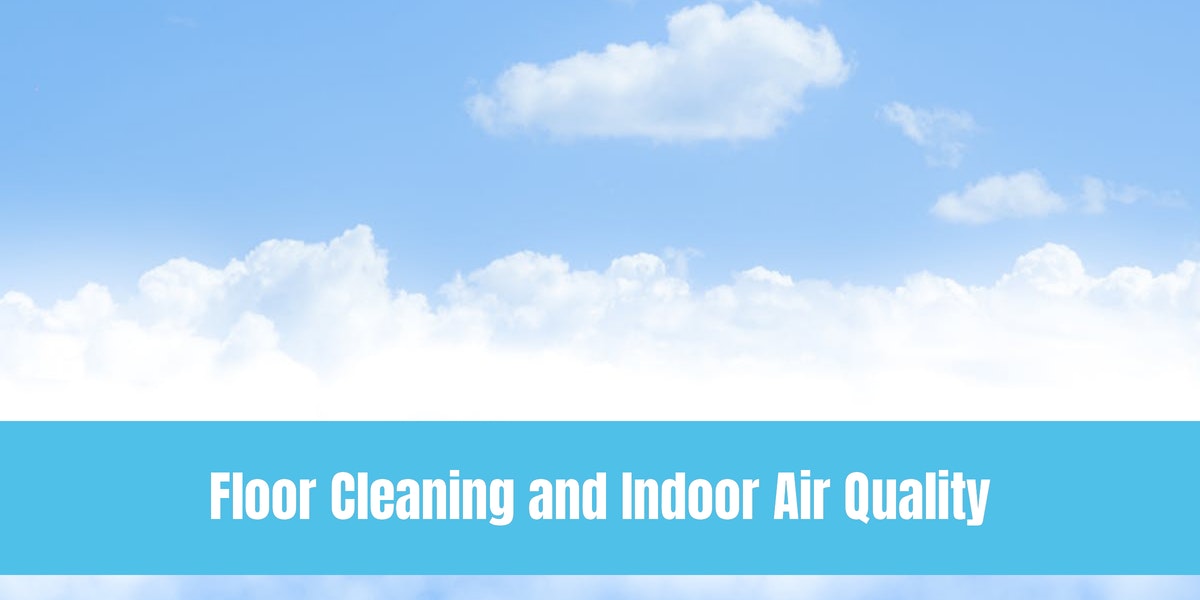An often unnoticed and ignored component of indoor air quality (IAQ) are clean carpets and floors.

Improving Indoor Air Quality With High-Performance Floor Care
Absent foul or overpowering odors, indoor air quality and pollution is something few people consider as they go about their day--most of which is spent indoors.
However, several studies have shown that the quality of the air inside can typically range between two to five times more polluted than the air outside, which harms our health and performance at work or in the classroom.
These conditions lead to a host of health issues, sometimes referred to as sick building syndrome, including:
- Headaches.
- Skin irritation.
- Nausea.
- Allergies
- Respiratory issues, and;
- Lung cancer.
An often overlooked source of indoor air pollution is the dirt, germs, bacteria, and chemicals transferred into a facility on the outside of shoes, underscoring the need for high-performance floor care services combined with well-maintained and strategically placed floor matting.
What's on Your Shoe?
Several studies have shown that a disturbing amount of chemicals, germs, and bacteria exist on the exterior of our shoes, including:
- E. Coli.
- C. Diff.
- Klebsiella.
- Serratia.
- Pesticides.
- Fertilizers, and;
- Chemicals from asphalt paving.
A study conducted by University of Arizona professor, Dr. Charles Gerba, gave ten participants a brand new pair of shoes and then tested the exterior after two weeks.
According to Eco Child's Play;
After two weeks, more than 420,000 units of bacteria were found on the outside of the test shoes. Of that bacteria, 27% were deadly E. Coli.
Also detected was Klebsiella pneumonia, which can cause pneumonia and wound and bloodstream infections and Serratia ficaria, which can lead to infection of the respiratory tract.
The common occurrence (96 percent) of coliform and E. coli bacteria on the outside of the shoes indicates frequent contact with fecal material, which most likely originates from floors in public restrooms or contact with animal fecal material outdoors.
[The] study also indicated that bacteria can be tracked by shoes over a long distance into your home or personal space after the shoes were contaminated with bacteria.
Even more disturbing to moms of little ones – 90 to 99% of bacteria found on the exterior of the shoes was transmitted to hard tile and carpet.
Any germs picked up by bare feet, knees and hands will then be transported to the crib at naptime.
Tips for High-Performance Floor Care to Improve Indoor Air Quality
Improving indoor air quality is a relatively simple matter--identify the source and remove it.
In regards to floor care, that means two things:
- Preventing dirt, germs, and bacteria from entering the building, and;
- Cleaning with green or safer choice products to prevent the release of volatile organic compounds (VOCs) into the air.
Prevention starts at the entrance and requires the implementation and maintenance of high-quality entry and walkway matting.
Additionally, depending on the work environment and local weather, scrapers which remove mud and brush the sides of shoes will remove debris from heavily soiled shoes.
Mats should also be placed in heavily trafficked paths throughout the building, which serves the added advantage of maintaining the carpet or floor for longer periods.
Placing specialized mats outside of restroom exits will aid in the removal of the numerous germs and bacteria that are transferred from restroom floors to the rest of the building.
Further:
- Carpets and mats should be vacuumed every day.
- Hard floors should be swept and mopped every day.
- Restrooms should have their floors scrubbed at least weekly.
- Carpets and other flooring should be shampooed and professionally treated at least twice per year, typically after the winter and summer seasons.
- Hard floors should be scrubbed and polished at least once per year, depending on the amount of foot traffic.
- Microfiber-based products remove more dirt, germs, and bacteria than cotton mops and brush or straw brooms.
- Implementing cross-contamination controls, such as color-coded microfiber and the two-bucket method will prevent germs and bacteria from spreading from one part of the building to another.
Remember, it is vital that your custodial staff maintain the equipment used to clean and disinfect the facility regularly, or you will eventually run into cross-contamination issues, resulting in increased health issues.
References & Resources
- How Does Indoor Air Quality Impact Student Health and Academic Performance?
- Improve Your IAQ
- 3 Gross Reasons You Shouldn’t Wear Shoes In The House
Takeaway
Maintaining a high level of indoor air quality is critical to the health and productive output of all facility occupants.
Implementing high-quality floor care focused on cleaning for health first combined with high-performance entry and walkway matting is a proven strategy to reduce the number of germs, bacteria, and chemical toxins brought into a facility from outside on the exterior of footwear.
Outsourcing your facilities' floor care services is a proven cost-effective method for managing costs while maintaining quality.
If you would like more information regarding the importance of high-performance floor care and systems, or if you would like to schedule a free, no-obligation onsite assessment of your facilities' infection prevention and control requirements, contact us today for a free quote!
In Bakersfield CA, call (661) 437-3253
In Fresno CA, call (559) 206-1059
In Valencia CA, or Santa Clarita CA, call (661) 437-3253

